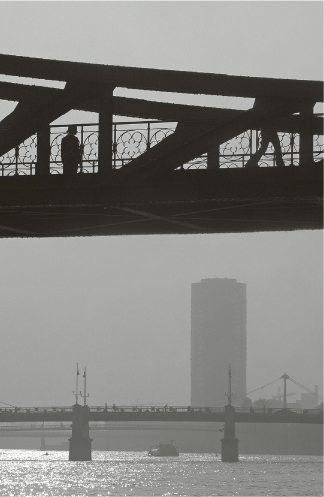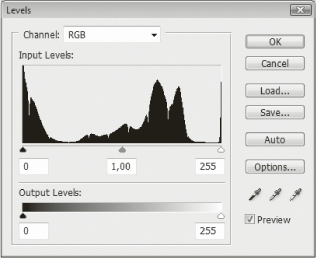9 The Graphic Element in Black and White Photography
Black and white photography restricts the image to black, white, and gray tones. You can even eliminate gray tones in a black and white image to create a strong composition. Reduction is a very important design element—not just in photography, but in modern art as well. Many painters (such as Piet Mondrian) gradually moved from a complex composition to simple shapes, to the point of almost reducing the picture to a monochromatic surface.
However, black and white photography is about something else: An image without color emphasizes the graphic form. In black and white photography, pictorial content is based on a more or less graphic, abstract image structure. Photojournalism can also strongly convey the content, such as in this basic graphic structure. A fundamental component of black and white photography is the interaction of light and shadow. Looking through the viewfinder, it is essential to abstract and design the interaction between light and shadow. This is easier said than done because it is not always so easy to ignore the influence of color. With good digital cameras, it is possible to take one test photo in black and white mode and view the image on the camera’s display. The final picture should be taken in color mode, however, and converted to black and white with an image manipulation program.
The Russian photographer Alexander Rodchenko (mentioned earlier) was one of the first photographers to allow the abstract, graphical structure of an image to dominate its content. In Girl with a Leica, one of his most famous photographs, he not only tilts the bench on which the young woman is sitting to make it a diagonal, he also uses a monochromatic play of light and shadow scattered over the entire scene. The photo does not intend to show the girl as an individual; it is all about a fascinating compositional design.
Another outstanding personality, this time of post-war Germany, was Otto Steinert, whose works helped post-war photography reach new heights. Under the concept of “subjective photography,” he postulated the photographic medium as the expression of one’s own feelings and moods. He was a master of abstract structures, radical crop, contrasty prints, and the representation of sometimes surrealistic moods. His negative prints and solarizations follow the tradition of Man Ray and László Moholy-Nagy. His best-known photo shows a moving, blurred pedestrian photographed from above with a tree trunk surrounded by a graphically interesting, circular rusty grid. The emotionally charged subjective photography created with the help of all graphic elements had a profound and long influence on post-war photography until the rather down-to-earth Becher School gradually created a sort of movement against it.
One of the early masters of graphic design was the Hungarian photographer André Kertész. Many of his works now rank among the most famous photographs of the last century. His photograph of a fork on the edge of the plate is an example of one of the first very simple, abstracted, minimalist representations of an object and its shadow. Kertész was one of the first photographers who captured the ordinariness of everyday life in a wonderfully graphic way. It’s sad that he had to suffer the loss of many of his negatives twice in his life. He was a friend of Brassai’s, whom he also impressively portrayed.
Such graphic black and white photography does not play an important role in contemporary art. However, black and white photography characterized by such pictorial compositions is still very much in demand in photojournalism. The war photographer James Nachtwey is an example of how someone can combine good graphic design in the tradition of Cartier-Bresson with the incredible emotional charge of a tragic subject matter. Nachtwey is certainly the best-known war photographer of modern times. A film made about him has helped to make his work known to a wider audience. He works intentionally in black and white, because with color photography there is always the risk of putting an attractive, esthetic veil over things. A moody sunset in orange would surely be counterproductive to depicting the intentions of war.
The grand master Henri Cartier-Bresson also consciously chose to work in black and white. He was unsurpassed when it came to capturing decisive human moments; he incorporated these moments in a complex pictorial event in which the abstract, graphic composition was the perfect fundamental element. This photographer stressed the graphic blending of man with his more or less architectural surroundings.
Light and Shadow as Basis of Compositional Design
In the unspectacular photo in figure 9–1, light and shadow are the real subject matter. The family has been reduced to shadows. The paving of the sidewalk is deteriorating. In the middle of the image, a large piece of concrete has broken loose, and the cracks in the concrete create interesting, organically flowing lines everywhere in this photo. In addition, the concrete stone blocks create a network of lines that flow uniformly. This network, made up of uniform and organic lines, is an element of tension with respect to the interesting shadows. Here, the design has reduced reality (i.e., people) to their shadows only. The photo was taken in New York and proves that the skyline with the Brooklyn Bridge does not always have to be the only interesting pictorial subject. You can probably take images such as this one right in front of your doorstep; you must only change your way of looking. Instead of setting your sights on reality, look downward to discover the world of shadows. Once you do this, you may capture the exciting moment that will result in a successful composition, which is created by the interesting graphic structure of the shadows.
The photo was taken with a 28 mm lens.
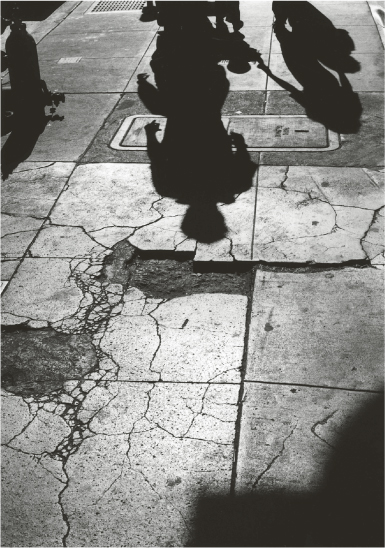
axial symmetry: Axial symmetry refers to the popular definition of symmetry as mirroring in respect to an axis. Axial symmetry primarily differs from other kinds of symmetry by containing objects that mirror each other. Furthermore, the mirroring objects relate to each other across a given axis that is either marked or unmarked.
The axial symmetric picture consists of two mirroring parts which start out by counterbalancing each other compositionally, thus often creating compositions that are statically in balance. (Description refers to Figure 9–2, see next page.)
Reduction to Verticals and Horizontals
The photo in figure 9–2 of the old Frankfurt stock exchange building is an image that makes do with almost no intermediate tones and therefore has an extremely powerful graphic impact.
The photo was taken digitally with a 200 mm focal length under backlit conditions. Looking at the histogram (figure 9–3), you can see that almost all medium tones are missing. When measuring the exposure, it was essential not to allow any light to burn out and to have some texture in the shadows of the beams. In good digital cameras, it is possible to adjust a mode on the Info key that, when blinking, indicates where the lights have burned out. If burnout has occurred, try to underexpose the photo a bit until nothing important blinks any longer in the display. The image is composed symmetrically around the axis formed by the central vertical girder. Without the addition of human subjects, the image would appear formal or even dull. However, the three silhouettes make the image interesting. The lower pair are obviously involved in a conversation, and the person on the upper floor is busily on the way to somewhere. This abstract depiction of people within a modern architectural structure embodies the true essence of black and white photography.
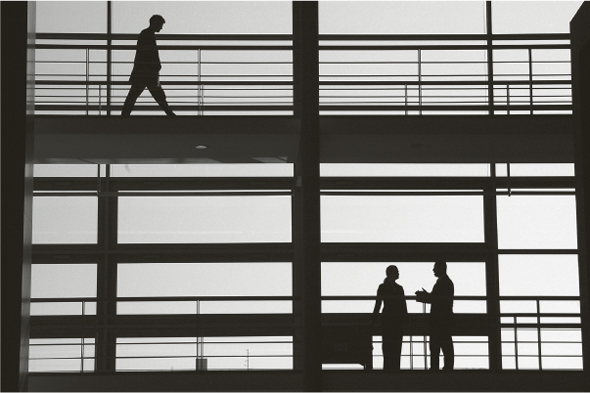
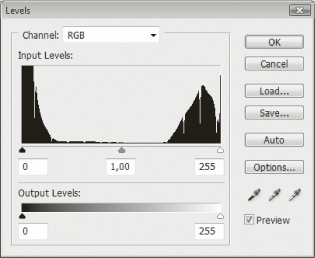
The Lively Finishing Touch
In the photo in figure 9–4, it was important to move away from the rather colorful design of Frankfurt’s Zeil shopping arcade and create an abstract, graphic pattern within the entire architectural variety found in this arcade. To organize the various structures in this photo, it made sense to create a basic symmetry on which the composition could rest. Thus, the escalator becomes the vertical symmetrical axis from which the image to its left and right has a roughly matching symmetry. This symmetry, however, is not rigid but is broken up by sufficient detailed shapes. The photo’s basic graphic structure is thus an interaction of long diagonal lines and short horizontal lines as well as of many smaller rectangles that make up the floor structure. Embedded into this pattern lies the photo’s finishing touch: a girl in the middle of the scene who extends her arms and legs. A second girl follows behind, but she doesn’t stand out as much. The girl in the center of the picture breathes life into the photo because without her, the architecture would have been too rigid.
Needless to say, it was necessary to wait a long time until this scene could be taken with a 20 mm lens.
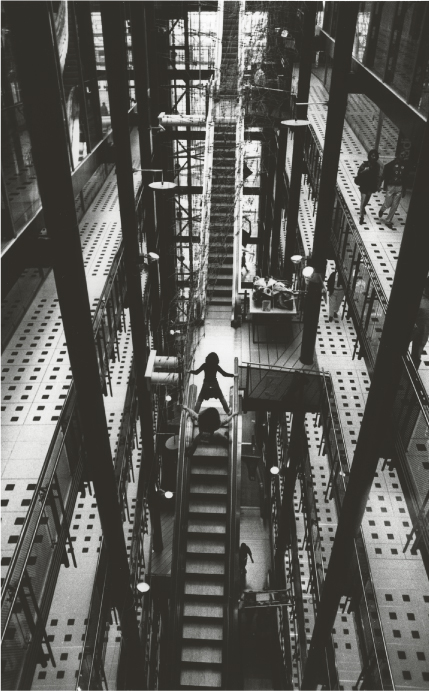
Lounge Chair on the Crosswalk
The photo in figure 9–5 reminds one of a Hitchcock movie. A broken lounge chair lying in the middle of a crosswalk obstructs the view. On the crosswalk you can see nothing more than a discarded water bottle, the shadow of a traffic light, and a man’s legs and his shadow. Houses around the crosswalk are not included in the photo, and even the end of the crosswalk is hidden from view, as is the actual shape of the man. Perhaps all these unknown elements are what lend a somewhat eerie quality to this photo. The graphic structure also gives its content a marked pictorial rhythm: The gradually narrowing lines of the crosswalk match the rhythm of the lounge chair’s lines that are perpendicular to them. Once again, without the cropped man and his shadow, this scene would have been rather monotonous. Here, a person has been embedded into an abstracted scene characterized by a pictorial rhythm that has graphic impact.
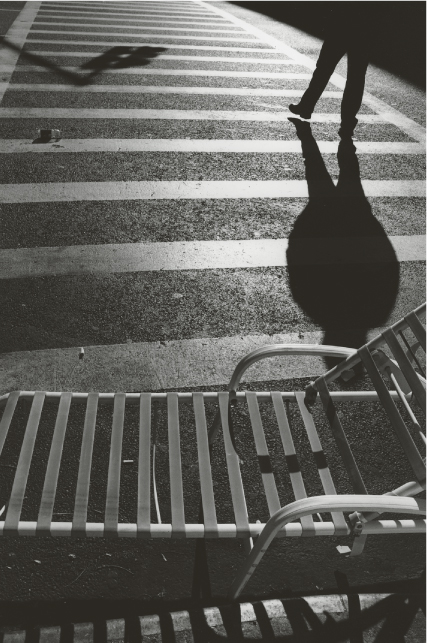
Iron Footbridge
LIFE magazine photographer Andreas Feininger repeatedly stressed how important it is to thoroughly examine an object before photographing it. This applies, naturally, only to immobile objects, not to snapshots. The iron footbridge in Frankfurt is such an immobile object, and therefore it made sense to first look carefully at it from all viewpoints in order to find its most photogenic angle. Such a steel bridge is ideal for creating a more or less intense graphic abstraction. Thus, the photo in figure 9–6 gets its esthetics almost exclusively from the shadows on the bridge, especially from the pictorial rhythm seen in the gradually narrowing rosettes of the railing, but also from the intense shadows of the supports. This composition would not have sufficed without the person’s legs approaching the viewer. The gradually receding shadows on the bridge create a movement toward the distance, and the approaching person, on the other hand, creates a forward, counteracting movement. This contrast gives the photo its dynamic quality. Once again, there are hardly any middle tones here, making this photo a graphic reduction.
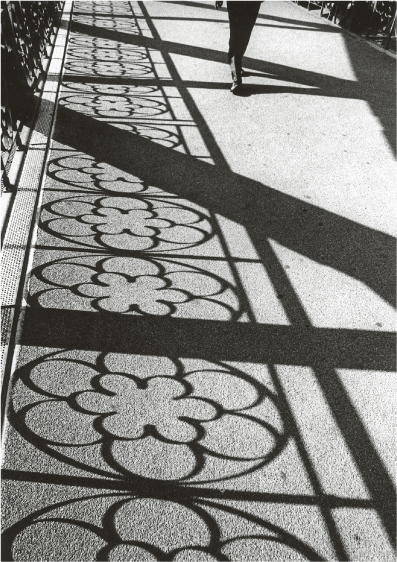
Another approach to photographing the same iron footbridge is seen in figure 9–7. This photo’s strength comes from the mood infused by the backlight. In spite of the backlight, it is very graphic, as can be read in the histogram (figure 9–8), because the diagram swings only in the black areas and in a rather bright gray area. In the upper part of the photo, the iron footbridge stands out graphically from the background; two persons give the photo some additional life—a standing figure in the upper left and another one reduced to show only legs on the upper right. Three more bridges provide an additional graphic element in the lower part of the photo. In addition, the new Westhafen Tower in Frankfurt rises majestically over the river, which is shimmering in black light.
The photo was taken digitally and proves, as mentioned several times, that a good digital camera can tackle back-light outstandingly as long as you underexpose the scene a bit and make sure not to burn out any lit areas.
